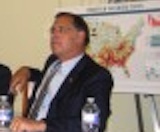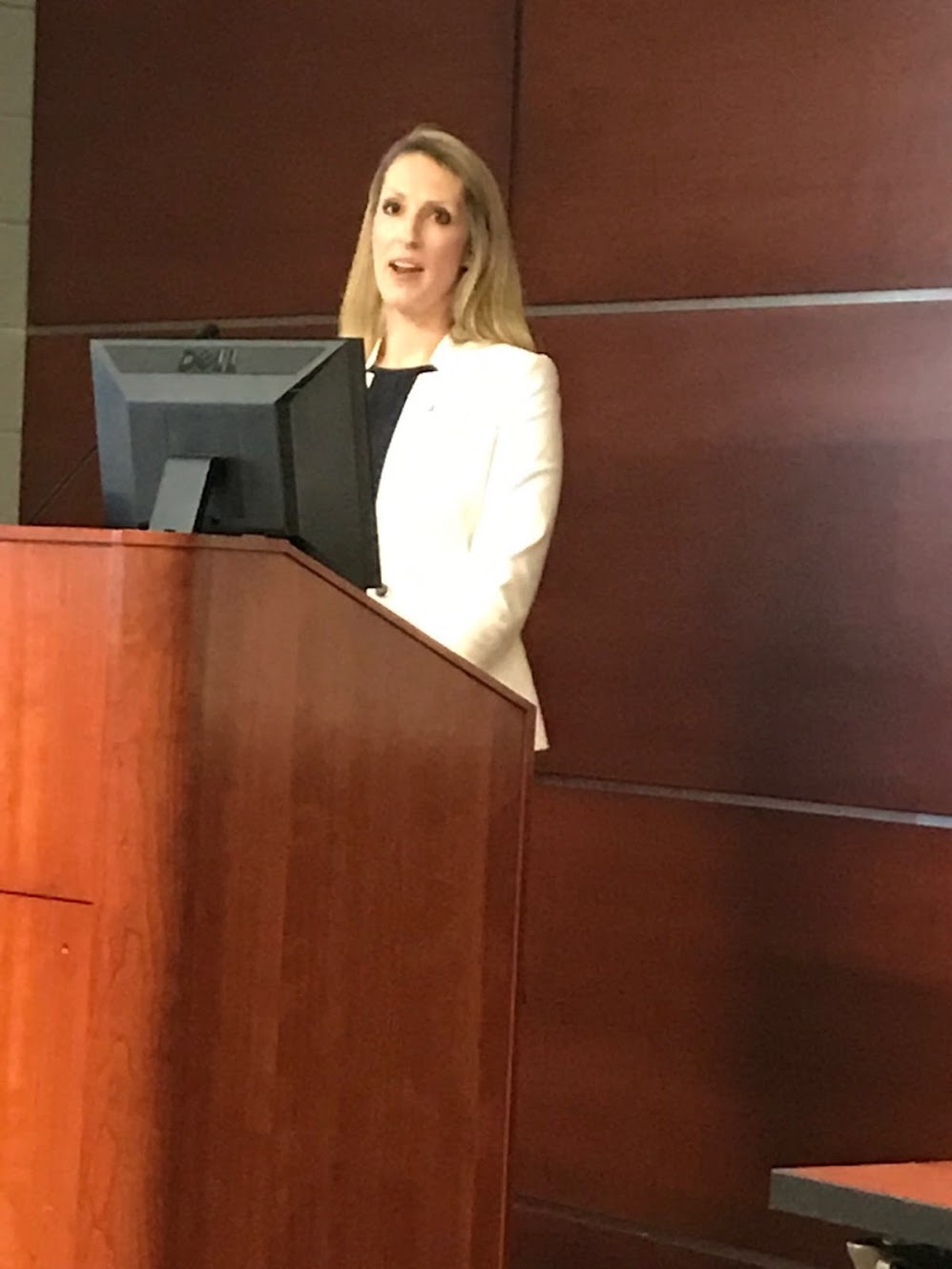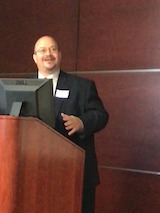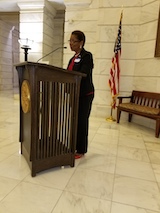Economic Equality Caucus
which advocates for economic equality across the USA.
| Home | Organizational Structure | State Coordinators | Executive Director | Caucus Articles | Memberships | |||||
| "Delta Vision, Delta Voices" | ||||||||||
|
Help Advocate for Economic Progress and Equality. Donate to the Delta Caucus/Economic Equality Caucus. |
||||||||||
Delta Grassroots Caucus Events

Credit Michael Hibblen/ KUAR News, Arkansas Public Radio; Former President Bill Clinton speaking to the Delta Grassroots Caucus on May 2, 2013, at the University of Arkansas Clinton School of Public Service, Little Rock

U. S. Senator John Boozman, Arkansas, at a Delta Grassroots Caucus meeting at the US Capitol

Brad Cole, Executive Director of the Municipal League of Illinois; previously a senior aide to former Republican US Sen. Mark Kirk of Illinois, earlier Mayor of Carbondale, Illinois, veteran Delta regional advocate, speaking at the Delta regional conference in West Memphis, Arkansas on April 26, 2019.

President Bill Clinton makes a comment to Delta Caucus Director Lee Powell at a meeting in Blytheville, Arkansas (in the northeast Arkansas Delta) on Nov. 2, 2014

The Delta Caucus would like to pay tribute to the late, great U.S. Sen. Thad Cochran of Mississippi, a powerful force in the US Senate for decades and a champion for the Delta. Sen. Cochran passed away on May 30, 2019. He spoke to the Delta Caucus on many occasions over the years (he is pictured above speaking to a Caucus event on Capitol Hill in Washington, DC) and his thoughtful, courteous and bipartisan leadership will be sorely missed.

Marcie Lawson, Executive Director, Sikeston, Missouri Regional Chamber and Area Economic Development Corporation, speaking at the Delta regional conference in West Memphis, Arkansas on April 26, 2019.

Alan Gumbel, Greater Memphis Alliance for a Competitive Workforce, Memphis, Tennessee, speaking at the Delta regional conference in West Memphis, Arkansas on April 26, 2019.

Mayor Shirley Washington of Pine Bluff, AR, speaking to the Delta Caucus at the Arkansas Capitol Rotunda in 2017.
Funding Levels for DRA, ARC and the 8 Regional Commissions in the USA
Posted on August 07, 2023 at 01:19 PM
August 8, 2023
Memorandum
From: Delta Grassroots Caucus
To: Advocates concerned with economic justice and equality
Re: Funding Issues for DRA and Discrepancy in Budgets of DRA, ARC and other regional commissions
These issues will be addressed at the Nov. 16-17, 2023 Delta Conference at the Clinton Library in Little Rock. Schedule and registration information is below at the bottom of this message.
Executive Summary
There are no less than 8 regional commissions in the USA, making up a hodge-podge of the ARC with its relatively huge budget, the DRA and the Northern Border Commission with modest budgets that are still too small per capita, and several other small commissions with even smaller budgets.
In addition to the DRA, ARC, Northern Border Regional Commission, there are the even smaller Southeast Crescent budget in the southeast US, the Southwest Border encompassing a huge area from southern California to much of southern Texas, the Northern Great Plains, the Great Lakes Authority and the Denali Commission in Alaska.
What we have now is an irrational hodge-podge with budgets determined by the vicissitudes of history, political clout and attentiveness of their Congressional and state political leaders.
The budgets need to be determined by sound, rational policy and not the accidents of history and politics. We can reform this by shedding the spotlight of information and knowledge on it.
Some of the commissions follow the absurd practice of including entire states–including large, relatively prosperous states like Florida or Minnesota–in the commissions’ jurisdiction. The entire reason for having regional commissions is to target funding to the most economically distressed counties. The geographical definition should have some reasonable resemblance to this basic intent.
The commissions’ boundaries were in many cases drawn for political reasons, but whatever the reason, if a result was absurd it needs to be corrected and reformed.
Summary of the facts of the commissions’ budgets and size of the regions.
What we need is a NATIONAL system based on objective criteria, including:
1) Needs and levels of poverty
2) Population—we just need a common sense approach. All the money shouldn’t go to a small number of people, but no one should be left out. Each person should be treated equitably, of course.
3) Geography and environmental factors should be considered, such as frigid weather in the Denali Commission and other Northern areas, frequent storms along the Gulf Coast, flooding in the Delta, mountainous areas as in Appalachia, arid conditions as in Southwest Border, etc. Each region has challenges so it needs to be assessed objectively and equitably.
4)Diversity and issues regarding discrimination against minorities such as African Americans, Hispanics, Native Americans, etc. Minorities should also include populations that have historically been marginalized, such as rural whites in Appalachia and other regions.
Other factors can be considered and we are open to suggestions.
Budgets and Areas Served by the Commissions
1. Appalachian Regional Commission–$400 million budget, covers parts of 13 states from northeast Mississippi to New York. Population for this region is about 26 million (although as with all the commissions the stature requires the majority of funding goes only to the most economically distressed).
The total combined budgets for all the eight commissions are $512 million, of which ARC has $400 million or almost 80 percent. We support the ARC and believe it deserves an increase as do all the commissions, but we need a sense of balance and equity among the commissions based on objective criteria.
2. Northern Border Regional Commission–$40 million budget covering all of Vermont, parts of New Hampshire and Maine, part of northern New York, population served is not readily available but would be estimated at five or six million. (We would encourage all the commissions to publish the total number of people they serve in the interests of transparency and information).
3. Delta Regional Authority–$30 million budget covering parts of eight states from southern Illinois and Missouri to Louisiana and eastward to the Alabama Black Belt–population of about 10 million.
4. Southeast Crescent Regional Commission–$20 million budget for most of Virginia, North Carolina, South Carolina, Georgia, all of Florida and small parts of southeast Alabama and Missisippi. The vast territory of this commission covers 428 counties.
With the exception of South Carolina, these states are relatively large and prosperous and have larger separate state government funding and resources to promote economic progress than do most of the Delta and Appalachian states. We are referring here, of course, to the state government budget that is separate from the specialized SCRC regional commission budget.
This covers the entire, huge state of Florida with its 23 million people and the fourth largest economy among the 50 states. The definition of the region should be reformed to cover the most economically distressed areas in the state, along with other appropriate efforts to follow the sound policy of targeting the most impoverished communities.
5. Denali Commission in parts of Alaska–$17 million. The population here is relatively small, but they face frigid weather in remote, low-income rural communities.
6. Southwest Border Regional Commission–$5 million to cover a massive region including southeast California, large regions of the border in Arizona, New Mexico and a large part across southern Texas.
7. Northern Great Plains Commission contains all of five states and most of Missouri (except for the southeast Missouri Delta area)–the funding has lapsed. No funding.
This is all of North Dakota, South Dakota, Nebraska, Minnesota, Iowa and most of Missouri.
Five of these states are relatively prosperous and rank above average nationally in poverty (see data below), and South Dakota at 25th in poverty is right in the middle. Including all of relatively prosperous states is not the most sound policy–the jurisdiction area should be targeted to the most impoverished areas.
8. Great Lakes Authority—all of Michigan and parts of northwest New York, part of Wisconsin, and a little of northeast Minnesota.. It is currently not active.
This includes all of Michigan—which again is not consistent with the targeted approach toward the most impoverished communities that regional commissions are supposed to follow. There is certainly poverty in Michigan but to include the whole state is just a shotgun approach that should not be followed—it needs to be pinpointed to the areas most in need.
Lee Powell, Delta Grassroots Caucus (202) 360-6347 More details are below in the extended section for those interested.
You register and RSVP by paying the $100 Registration fees. Info on how to pay is below.
Schedule
The Friday session on Nov. 17, 2023 is at the Clinton Library Great Hall from about 8:45 a.m. to 1 p.m. The opening session is Thursday, Nov. 16, 2023 from 4:45 p.m. to 6:30 p.m.
Opening session will be on Thursday evening, November 16, 2023 from about 4:45 p.m. to 6:30 p.m. at a central Little Rock location, (probably the Arkansas Capitol Rotunda but they do not take reservations this far ahead of time).
Clinton Library Great Hall session is set for Friday, November 17, 2023 from 8:45 a.m. to 1 p.m. or 1:30 p.m.
GROUP HOTEL
The group hotel is the Comfort Inn & Suites Presidential in Little Rock. To get the group rate call the hotel at 501-687-7700 and say you are with the Delta Caucus group.**
REGISTRATION FEES
You register and RSVP by paying the $100 registration fees.
GROUP DISCOUNTS: If you can bring a group of three or more, we will give a group discount down to $50 each, and for a group of four or more we will reduce it to $30 each.
The easiest way to register is to go on the website at mdgc.us and go to the Paypal link that says “Donate.”
If you prefer to pay by check, make out the check to “Delta Caucus” and mail to our office in the Washington, DC area:
Delta Caucus
5030 Purslane Place
Waldorf, MD 20601
Extended content section is below on the website:
DATA ON THE EIGHT REGIONAL COMMISSIONS ACROSS THE USA
What we have now is an irrational hodge-podge with budgets determined by the vicissitudes of history, political clout and attentiveness of their Congressional and state political leaders.
We are summarizing here the facts of the commissions’ budgets and size of the regions.
What we need is a NATIONAL system based on objective criteria, including:
1) Needs and levels of poverty
2) Population—we just need a common sense approach. All the money shouldn’t go to a small number of people, but no one should be left out. Each person should be treated equitably, of course.
3)Geography and environmental factors should be considered, such as frigid weather in the Denali Commission and other Northern areas, frequent storms along the Gulf Coast, flooding in the Delta, mountainous areas as in Appalachia, arid conditions as in Southwest Border, etc. Each region has challenges so it needs to be assessed objectively and equitably.
4)Diversity and issues regarding discrimination against minorities such as African Americans, Hispanics, Native Americans, etc. Minorities should also include populations that have historically been marginalized, such as rural whites in Appalachia and other regions.
Other factors can be considered and we are open to suggestions.
We support our colleagues in Appalachia and we think they deserve everything they have, and probably more in terms of their budget. This is not a zero-sum game. We are asking for adequate budgets for ALL regions.
Here are their budgets and territory in a nutshell:
1) ARC budget is $400 million.
It has parts of 13 states and covers a population of 26 million people, although as in all the commissions only some of them live in economically distressed counties that should receive most of the funding.
2) Northern Border Regional Commission has $40 million for parts of four states and a population of about 4.5 million.
Population of about 4.5 million, again many not impoverished, in parts of four states.
This encompasses all of Vermont, most of New Hampshire and Maine, and a stretch of northern New York.
The total populations of Vermont, New Hampshire and Maine add up to about 3.3 million, and northern New York would add another million or so. Many of those areas are not in the economically distressed category.
Vermont, New Hampshire and Maine on the whole do not have poverty levels as severe as other regions–New Hampshire in fact has either the lowest or one of the few lowest poverty rates, Vermont also ranks low in poverty, and Maine is above average, according to US News and World Report:
Lowest poverty rankings:
1. New Hampshire–lowest poverty level in the USA
2. Vermont–9th lowest poverty level
3. Maine–21st lowest poverty level
These three states make up the great majority of this region. There are needs here and the frigid weather throughout much of the year should be taken into consideration.
Based on the facts, this region is relatively much more prosperous than most of the other regions and is clearly above average in the key economic indicators.
There are certainly areas in northern New York with severe poverty levels. The definition of the Northern Border region and the Appalachian region should be careful not to overlap and create duplication, because both have areas in their jurisdiction in New York.
There are certainly legitimate reasons for this commission. In a fair determination of the budgets, economic and demographic issues should be considered, as with all the commissions.
3) DRA has $30 million for parts of eight states.
Population is about 10 million. This is the most impoverished region in the country, as the data below indicate–six of the 10 most impoverished states and four of the six most impoverished states are in the Delta.
Aside from parts of Little Rock, Memphis and New Orleans (all of which have prosperous areas but also some impoverished neighborhoods) and a few prosperous islands like Jonesboro, this is the most impoverished region in the country.
The DRA also covers the Alabama Black Belt, in addition to the seven Mississippi River Delta states.
Here are the 10 states with the highest poverty rates in the USA (from World Population Review):
Mississippi - 19.26%
Louisiana - 18.56%
New Mexico - 18.06%
West Virginia - 17.01%
Kentucky - 15.89%
Arkansas - 15.35%
District of Columbia - 15.32%
Alabama - 14.96%
Oklahoma - 14.46%
Tennessee - 13.53%
Six of the worst 10 states with highest poverty levels are in the Delta and Alabama Black Belt, and four of the worst six states are in the Delta.
The Southwest Border and Appalachia have two states among the four most impoverished, with New Mexico third and West Virginia fourth.
NOTE: The Southwest Border region covers a vast area including huge territory in Texas, New Mexico, Arizona and California. Having fewer states included in this region does not change the fact that it is quite extensive, as are the Delta and Appalachia.
NOTE: There are some differences among organizations who calculate the rankings. World Population Review is a reputable organization and for the most part broadly similar to other rankings.
Arkansas, Louisiana and Mississippi are at the heart of the region and they are regularly at the bottom or near the poverty and food insecurity rankings. New Mexico and West Virginia are the only states ranking at the bottom with Delta states.
The Alabama Black Belt of course is also among the most impoverished areas nationwide.
While the DRA’s budget of $30 million is too small, we need to recognize that we are the third highest in funding among the commissions, so most of the others have fared much worse than we have. This is especially true nowadays when we are up to $30 million from the doldrums when we had $6 million or so. We have made some progress.
4) Southeast Crescent Regional Commission has $20 million.
This is most of Virginia, North Carolina, South Carolina, and Georgia, parts of Florida, and small parts of southeast Alabama and southeast Mississippi.
There is no doubt there are pockets of poverty in these states, although of course Virginia, North Carolina, Georgia and Florida are large, overall relatively prosperous states with large resources.
South Carolina does have serious poverty areas and not as much resources as some of the larger states. The $20 million here relative to the other regions is perhaps not as low as most–given the resources of most of these large states–but this commission like the others deserves appropriate increases and equitable treatment.
This commission’s boundaries include the absurd result of including the entire state of Florida, with its large population of 23 million people and having the fourth largest economy of all the 50 states. There are many prosperous communities in Florida, although there are certainly areas of poverty.
It is painfully obvious that the commission should have targeted the areas with the largest poverty levels rather than throwing this entire vast state into the commission’s jurisdiction.
Large, relatively prosperous states like Virginia, Florida, and North Carolina, have much larger resources from their state budgets to help address the impoverished areas in this region. This should be taken into consideration along with other issues.
5. Denali Commission in parts of Alaska–$17 million.
The Denali Commission’s current activities are coastal infrastructure, energy infrastructure, and fuel storage. They no longer engage in general economic development and transportation, which were its original core elements and purpose.
This covers parts of one state that is relatively speaking not heavily populated (population of about 730,000 for the entire state in 2023) as a factual matter. However, they do have frigid weather conditions much of the year that complicates their activities, along with substantial Native American population, and isolated rural communities spread over a vast geographical area.
Geographical and environmental factors clearly give appropriate considerations to Denali’s budget.
6. Southwest Border Regional Commission–$5 million to cover a massive region including southeast California, large regions of the border in Arizona, New Mexico and a large part across southern Texas.
There are many impoverished communities in this region, many of them Hispanic.
This is one of the most if not the most under-funded commission, given the region’s size and needs. Virtually all of them, of course, are seriously under-funded.
7. Northern Great Plains Commission contains all of five states and most of Missouri (except for the southeast Missouri Delta area)–the funding has lapsed. No funding.
This is all of North Dakota, South Dakota, Nebraska, Minnesota, Iowa and most of Missouri.
There is no doubt that there are many Native American reservations in this region that have probably the worst of all poverty in our nation.
But there are separate programs for Native Americans. These should be addressed by significant increases in the budgets for Native American populations here and across the USA.
For these states on the whole, their poverty rankings are actually significantly better than the national average.
Minnesota ranks 38th in poverty. So only 12 states have more poverty than Minnesota, which also ranks above average in population at 22nd and well above average in gross domestic product at 15th highest.
Minnesota has a larger population and is a relatively prosperous state with a stronger economy than many of the Delta, Appalachia and Southwest Border states, based on the data.
Poverty rankings of these states:
Minnesota is 38th lowest–only 12 states are better.
North Dakota is 35th.
Iowa is 31st.
Missouri is 30th. (The southeast Missouri Delta is impoverished, but much of the rest of the state is relatively prosperous.)
South Dakota is 24th.
Four of these states are well above average in poverty, and South Dakota is right at the middle.
As a factual matter, this region is simply not as impoverished as most of the other regions, again recognizing the special problem of substantial Native American populations there, which should be addressed by increases in the Native American programs.
We are not saying there shouldn’t be a regional commission there, but the funding levels should take objective criteria like resources from states’ resources and relatively large states like Minnesota and most of Missouri.
This commission merits a funding increase as do all the others, but factually speaking it is not as impoverished as DRA, ARC, Southwest Border and Denali.
There is some need here outside of the Native Americans but much less than Delta, Appalachia or Southwest Border.
8. Great Lakes Authority—all of Michigan and parts of northwest New York, part of Wisconsin, and a little of northeast Minnesota.. It is currently not active.
This includes all of Michigan—which is not consistent with the targeted approach toward the most impoverished communities that regional commissions are supposed to follow. There is certainly poverty in Michigan but to include the whole state is just a shotgun approach that should not be followed—it needs to be pinpointed to the areas most in need.
The appropriate way to draw up the boundaries for these commissions is to focus on areas of greater poverty. There are guidelines for channeling funding to economically distressed areas, but preventing the regional definition to become over-extended is wise policy, to prevent unwise funding decisions going to more prosperous, often more urban areas, than was intended in creating these commissions.
We need an equitable, fair and nationally planned system of regional commissions based on objective criteria, as noted above, such as poverty levels, population, geographical size and obstacles, diversity issues, and other key considerations.
This will have to be addressed at the national level, including the Biden administration, Congress, national anti-poverty and hunger organizations, along with representation from major anti-poverty organizations in the major regions. How to do this is another vast and complex subject.
Thanks. Lee Powell, Delta Caucus (202) 360-6347
Back to the top